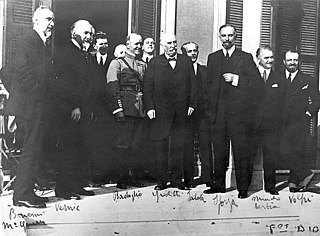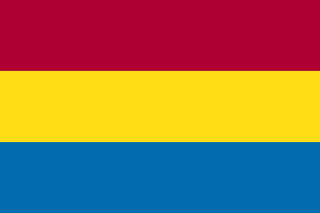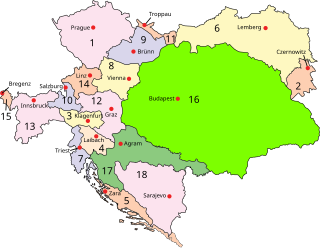The Italian National Council of Fiume was a political body that governed the city of Fiume between 1918 and 1924.
The Italian National Council of Fiume was a political body that governed the city of Fiume between 1918 and 1924.
Emperor Charles I of Austria, after Foreign Minister Baron István Burián asked for an armistice based on the Fourteen Points on 14 October 1918, issued two days later a proclamation that radically changed the nature of the Austrian state. According to the Volkermanifest the Poles were granted full independence with the purpose of joining their ethnic brethren in Russia and Germany in a Polish state. To prevent the total collapse of the monarchy the rest of the Austrian lands were transformed into a federal union composed of four parts—German, Czech, South Slav and Ukrainian. Each of the four parts was to be governed by a federal council, and Trieste was to receive a special status.
On the evening of the 28 October, Zoltán Jekelfalussy, the Hungarian governor of Fiume, called Mayor Antonio Vio to his office to give him the news that the Hungarian Government had decided that Fiume was to be abandoned both militarily and politically. The members of the Municipal Council knew they could no longer base its right to authority on his appointment by a power that no longer existed in its previous form. The Municipal Council invoking the right of self-determination, advocated by U.S. President Woodrow Wilson reappointed Vio as major and expanded its ranks to some 60 co-opted members. In the meanwhile the National Council of Slovenes, Croats and Serbs was officially instituted on 29 October 1918 in Zagreb. Representatives of the latter body arrived in the city and wrested command of the governor palace from Jekelfalussy who left the city. The city now had two self-proclaimed governments, each basing its claims on the same principle. The local representatives of the Municipal Council as a response formed immediately the Italian National Council, headed by Antonio Grossich. On 30 October the body proclaimed the annexation of Fiume to Italy [1]
Austria-Hungary reached an armistice with Italy through the Armistice of Villa Giusti signed on November 3, 1918. [2] This agreement stipulated that Italy could occupy large parts of the territory claimed by the State of Slovenes, Croats and Serbs, formed during the dissolution of the Habsburg Monarchy. The National Council of the Slovenes, Croats and Serbs in Fiume was dissolved when Italian Army units, commanded by General Enrico di San Marzano, occupied the city. The rule of the Italian National Council was tolerated by the Italian command, much less so by the American, English and French units who also came to the city.
At the Paris peace Conference Andrea Ossoinack was entrusted by the Italian National Council as its official representative and in that capacity had a meeting with Wilson in April 1919. The Italian National Council functioned as a de facto government (with interruptions) during both the Italian Regency of Carnaro (1919–1920) and the Free State of Fiume (1920–1924). The city was annexed to Italy in February 1924, thereby ending its authority.

The Treaty of Rapallo was an agreement between the Kingdom of Italy and the Kingdom of Serbs, Croats and Slovenes in the aftermath of the First World War. It was intended to settle the Adriatic question, which referred to Italian claims over territories promised to the country in return for its entry into the war against Austria-Hungary, claims that were made on the basis of the 1915 Treaty of London. The wartime pact promised Italy large areas of the eastern Adriatic. The treaty, signed on 12 November 1920 in Rapallo, Italy, generally redeemed the promises of territorial gains in the former Austrian Littoral by awarding Italy territories generally corresponding to the peninsula of Istria and the former Princely County of Gorizia and Gradisca, with the addition of the Snežnik Plateau, in addition to what was promised by the London treaty. The articles regarding Dalmatia were largely ignored. Instead, in Dalmatia, Italy received the city of Zadar and several islands. Other provisions of the treaty contained safeguards for the rights of Italian nationals remaining in the Kingdom of Serbs, Croats and Slovenes, and provisions for commissions to demarcate the new border, and facilitate economic and educational cooperation. The treaty also established the Free State of Fiume, the city-state consisting of the former Austro-Hungarian Corpus separatum that consisted of Rijeka and a strip of coast giving the new state a land border with Italy at Istria.

The State of Slovenes, Croats and Serbs was a political entity that was constituted in October 1918, at the end of World War I, by Slovenes, Croats and Serbs (Prečani) residing in what were the southernmost parts of the Austro-Hungarian Empire. Although internationally unrecognised, this was the first incarnation of a Yugoslav state founded on the Pan-Slavic ideology. Thirty-three days after it was proclaimed, the state joined the Kingdom of Serbia to form the Kingdom of Serbs, Croats and Slovenes.

The Corfu Declaration was an agreement between the prime minister of Serbia, Nikola Pašić, and the president of the Yugoslav Committee, Ante Trumbić, concluded on the Greek island of Corfu on 20 July 1917. Its purpose was to establish the method of unifying a future common state of the South Slavs living in Serbia, Montenegro and Austria-Hungary after the First World War. Russia's decision to withdraw diplomatic support for Serbia following the February Revolution, as well as the Yugoslav Committee's sidelining by the trialist reform initiatives launched in Austria-Hungary, motivated both sides to attempt to reach an agreement.

The Yugoslav Committee was a World War I-era, unelected, ad-hoc committee that largely consisting of émigré Croat, Slovene, and Bosnian Serb politicians and political activists, whose aim was the detachment of Austro-Hungarian lands inhabited by South Slavs and unification of those lands with the Kingdom of Serbia. The group was formally established in 1915 and it last met in 1919, shortly after the breakup of Austria-Hungary and the establishment of the Kingdom of Serbs, Croats and Slovenes, which was later renamed Yugoslavia. The Yugoslav Committee was led by its president the Croat lawyer Ante Trumbić and, until 1916, by Croat politician Frano Supilo as its vice president.

The Kingdom of Dalmatia was a crown land of the Austrian Empire (1815–1867) and the Cisleithanian half of Austria-Hungary (1867–1918). It encompassed the entirety of the region of Dalmatia, with its capital at Zadar.

The Free State of Fiume was an independent free state that existed between 1920 and 1924. Its territory of 28 km2 (11 sq mi) comprised the city of Fiume and rural areas to its north, with a corridor to its west connecting it to the Kingdom of Italy.

The Lands of the Crown of Saint Stephen, informally Transleithania, were the Hungarian territories of Austria-Hungary, throughout the latter's entire existence, and which disintegrated following its dissolution. The name referenced the historic coronation crown of Hungary, known as the Crown of Saint Stephen of Hungary, which had a symbolic importance to the Kingdom of Hungary.

Yugoslavia was a state concept among the South Slavic intelligentsia and later popular masses from the 19th to early 20th centuries that culminated in its realization after the 1918 collapse of Austria-Hungary at the end of World War I and the formation of the Kingdom of Serbs, Croats and Slovenes. However, the kingdom was better known colloquially as Yugoslavia ; in 1929 it was formally renamed the "Kingdom of Yugoslavia".
The Autonomist Association was a political party in Fiume, that existed continuously from 1896 to 1914. Its goal was to maintain the autonomy of the corpus separatum of Fiume within the Hungarian Kingdom.
Rijeka, formerly known as Fiume, is a city located in the northern tip of the Kvarner Gulf in the northern Adriatic. It is currently the third-largest city in Croatia. It was part of the Roman province of Dalmatia, and later of the Kingdom of Croatia. It grew during the 12th to 14th centuries as a seaport within the Holy Roman Empire, trading with Italian cities. Under the rule of the House of Habsburg from 1466, it was made a free city; and, although part of the Duchy of Carniola, it developed local self-government.

Corpus separatum, a Latin term meaning "separated body", refers to the status of the City of Fiume while given a special legal and political status different from its environment under the rule of the Kingdom of Hungary. Formally known as City of Fiume and its District, it was instituted by Empress Maria Theresa in 1779, determining the semi-autonomous status of Fiume within the Habsburg monarchy until the fall of the Austro-Hungarian Empire in 1918.
In the aftermath of the First World War, the Adriatic question or Adriatic problem concerned the fate of the territories along the eastern coast of the Adriatic Sea that formerly belonged to the Austro-Hungarian Empire. The roots of the dispute lay in the secret Treaty of London, signed during the war, and in growing nationalism, especially Italian irredentism and Yugoslavism, which led ultimately to the creation of Yugoslavia. The question was a major barrier to agreement at the Paris Peace Conference, but was partially resolved by the Treaty of Rapallo between Italy and Yugoslavia on 12 November 1920.
The National Council of Slovenes, Croats and Serbs claimed to represent South Slavs living in Austria-Hungary and, after its dissolution, in the short-lived State of Slovenes, Croats and Serbs. The council's membership was largely drawn from various representative bodies operating in the Habsburg crown lands inhabited by South Slavs. The founding of the National Council in Zagreb on 8 October 1918 fulfilled the Zagreb Resolution to concentrate South Slavic political forces, adopted earlier that year on the initiative of the Yugoslav Club. The council elected Anton Korošec as the president and Svetozar Pribićević and Ante Pavelić as vice-presidents.

The dissolution of Austria-Hungary was a major geopolitical event that occurred as a result of the growth of internal social contradictions and the separation of different parts of Austria-Hungary. The more immediate reasons for the collapse of the state were World War I, the 1918 crop failure, general starvation and the economic crisis. The Austro-Hungarian Empire had additionally been weakened over time by a widening gap between Hungarian and Austrian interests. Furthermore, a history of chronic overcommitment rooted in the 1815 Congress of Vienna in which Metternich pledged Austria to fulfill a role that necessitated unwavering Austrian strength and resulted in overextension. Upon this weakened foundation, additional stressors during World War I catalyzed the collapse of the empire. The 1917 October Revolution and the Wilsonian peace pronouncements from January 1918 onward encouraged socialism on the one hand, and nationalism on the other, or alternatively a combination of both tendencies, among all peoples of the Habsburg monarchy.
In the aftermath of the First World War, the Fiume Question, part of the larger Adriatic Question or Adriatic Problem, concerned the fate of the territory that was part of the Corpus Separatum of Fiume, the Royal Free City and one of the only two free ports of Austria-Hungary.
The armistice of Belgrade was an agreement on the termination of World War I hostilities between the Triple Entente and the Kingdom of Hungary concluded in Belgrade on 13 November 1918. It was largely negotiated by General Louis Franchet d'Espèrey, as the commanding officer of the Allied Army of the Orient, and Hungarian Prime Minister Mihály Károlyi, on 7 November. It was signed by General Paul Prosper Henrys and vojvoda Živojin Mišić, as representatives of the Allies, and by the former Hungarian Minister of War, Béla Linder.

The Lipošćak affair was an alleged conspiracy led by the former Austro-Hungarian Army General of the Infantry Anton Lipošćak to seize power in the recently proclaimed State of Slovenes, Croats and Serbs at the end of the First World War. The majority view of the allegations is that they were fabricated by allies of the Croat-Serb Coalition leader Svetozar Pribičević. Lipošćak was arrested on 22 November 1918 under suspicion of treason. He was accused of plotting to establish councils composed of workers, peasants and soldiers in place of the existing authorities with the aim of reviving the Habsburg monarchy, or working on behalf of foreign powers or the Bolsheviks.

The Geneva Declaration, Geneva Agreement, or Geneva Pact was a statement of political agreement on the provisional political system in the future union of the South Slavs living in the territories of the former Austro-Hungarian Empire and Kingdom of Serbia. It was agreed by Serbian Prime Minister Nikola Pašić on behalf of Serbia, representatives of Serbian parliamentary opposition, representatives of the National Council of the State of Slovenes, Croats and Serbs which recently seceded from Austria-Hungary, and representatives of the Yugoslav Committee. The talks held in Geneva, Switzerland on 6–9 November 1918 built upon and were intended to supersede the 1917 Corfu Declaration agreed by Pašić and Yugoslav Committee president Ante Trumbić. The basis for the talks was provided by the Greek Prime Minister Eleftherios Venizelos on behalf of the Supreme War Council of the Triple Entente. The talks were necessary in the process of creation of Yugoslavia as a means to demonstrate to the Entente powers that various governments and interests groups could cooperate on the project to establish a viable state.

In the immediate aftermath of World War I, the region of Međimurje was occupied by forces loyal to the National Council of the State of Slovenes, Croats and Serbs, one of the predecessor states to the Kingdom of Yugoslavia, in November and December 1918. Predominantly inhabited by Croats, this territory was a part of the Kingdom of Hungary until it was captured by Yugoslav forces. The region was annexed by Yugoslavia, which was awarded it at the Paris Peace Conference (1919–1920).

The occupation of the eastern Adriatic was a military mission of Allies of World War I conducted in the aftermath of the World War I, from November 1918 to September 1921. It involved deployment of naval assets and troops of the United Kingdom, the Kingdom of Italy, France, and the United States to parts of the territory of former Austria-Hungary, especially the region of Dalmatia and the city of Rijeka, as well as to the coastal areas of the Kingdom of Montenegro. The occupation was meant to resolve a number of issues, including disposal of assets of the Austro-Hungarian Navy, and settlement of Italian territorial claims on the eastern coast of the Adriatic Sea. Those claims, largely corresponding to the award made under the Treaty of London used to entice Italy to enter the war on the side of the allies, conflicted with the territorial claims of the nascent Kingdom of Serbs, Croats and Slovenes and its predecessor states, as well as the principle of self-determination outlined in the Fourteen Points of President Woodrow Wilson.